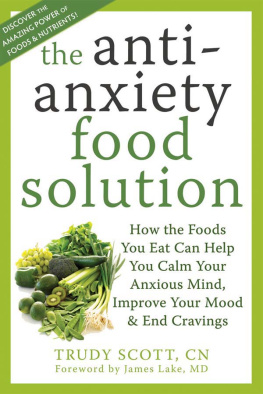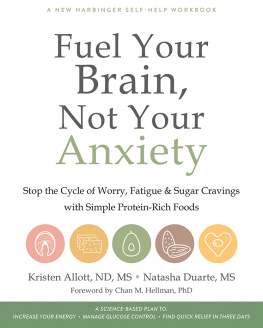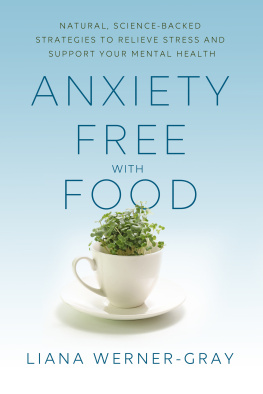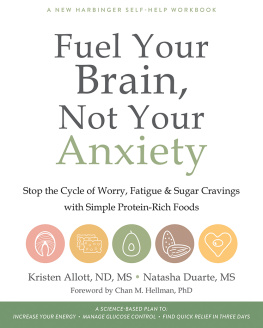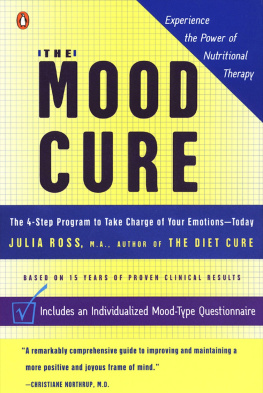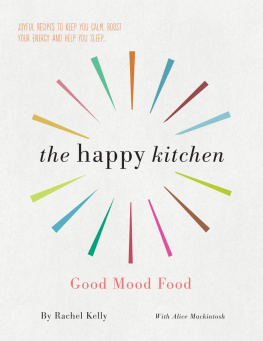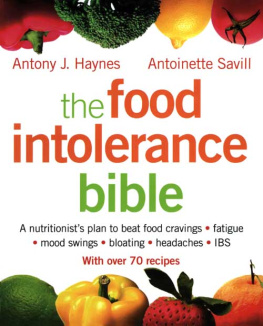Acknowledgments
Thanks to the following peer reviewers: Bonnie Fisk-Hayden, MS; Elizabeth Lipski, PhD, CCN; Karla Maree, CNC; James Lake, MD; Joan Mathews-Larson, PhD, Mikell Susanne Parsons, DC; Julia Ross, MA; and Michael Schachter, MD, CNS.
Thanks to my wonderful copyeditor, Jasmine Star.
Thanks to everyone behind the scenes who contributed to this end result.
Thanks to my mom, who helped so much with the initial typingand thanks for feeding us kids real whole food!
Last but not least, thanks to my wonderful husband, Brad, for your love and support, for making me laugh every single day, and for all the fun we have!
Appendix 1
Sues Story
All of the case studies throughout the book are real examples of people Ive worked with. Their stories demonstrate that we are all different, so we each need to figure out what our own unique nutritional needs are to determine what changes are needed. You may just need to make changes to your diet, or you may need to do more. I include the following case study here, because for this client the solution involved multiple approaches, covered throughout the book. Her story also shows the diversity of reasons for anxiety, and therefore the need for flexibility in approaches to alleviating it, and highlights the importance of finding the root cause of the issue, whether its eating poorly, not eating frequently enough, caffeine, poor digestion, gluten issues, or pyroluria.
Sues situation was more complex than that of most of my clients. She needed more testing and, ultimately, more supplements. A stay-at-home mom in her forties who played the violin in a community orchestra, Sue was anxious and experienced weekly panic attacks related to her musical performances. She typically felt anxious throughout the day, especially around bedtime. She said that shed always been anxious but that her anxiety had gotten worse in the last year. She was also tired and mildly depressed, and had pretty severe PMS, including bloating and emotional symptoms, especially tearfulness. She had major cravings for bread, pasta, and fats, with her absolute-favorite foods being big chunks of French bread with plenty of butter and pasta with creamy sauces. She said she loved these foods. Other than this, she ate fairly well, mostly eating a whole foods diet, with sufficient high-quality protein, good fats, and organic vegetables and fruit.
During our first appointment, I recommended that Sue take 250 mg of GABA for its relaxing effects. She immediately felt a sense of calm. She was visibly more relaxed and much more at ease. Because Sue had a number of symptoms of low serotonin (mild depression, winter blues and anxiety, perfectionism, afternoon cravings, and PMS), I also recommended that she try 50 mg of 5-HTP. The results were dramatic. Within ten minutes she felt more positive.
Because of her intense love for bread and pasta, I suspected that Sue also had low levels of endorphins. I recommended that she take D-phenylalanine (DPA) and a supplemental free-form amino acid blend to help raise her endorphins so that she wouldnt need to turn to food to self-soothe.
Sue had a very high score on the pyroluria questionnaire. She didnt recall her dreams, indicating a need for vitamin B. And when I had her do the zinc taste test, she didnt think the zinc solution had any taste, indicating a high need for zinc. I recommended that she take the following supplements, and she agreed to give it a try:
- A multivitamin with chromium
- A multimineral
- A B complex supplement
- 1,000 mg of vitamin C three times a day
- 50 mg of 5-HTP at midmorning and 100 mg of 5-HTP at midafternoon
- 250 mg of GABA on waking and at midmorning, and 250 to 500 mg at midafternoon and bedtime
- 1,000 mg of DPA at midmorning and midafternoon
- A free-form amino acid blend with every meal
- 30 mg of zinc
- 100 mg of vitamin B
At my recommendation, she had the tests for a wide variety of potential problems: IgG food allergies (including gluten), adrenal dysfunction, pyroluria, fatty acid deficiencies, and sex hormone imbalances. I also recommended basic blood work to determine her levels of vitamin D, ferritin, cholesterol, and so on. Given her mood problems and her craving for bread and pasta, I also recommended that she do a two-week gluten elimination-challenge trial, and she said shed start right away.
The week after her first appointment, Sue had no panic attacksnot a single one. She was thrilled and told me, For the first time in a long while, I have hope. She was feeling much less overwhelmed and more optimistic, and was sleeping well. However, she was still tired, and although her cravings were less intense, they were still a problem. I suggested she double her 5-HTP to help with the cravings, and this worked.
A week later, when Sue added gluten back into her diet, she felt more tired, spacey, and moody, and also slightly more anxious. Then her lab tests came in, confirming her sensitivity to gluten, along with a large number of other foods. Given the results shed already seen from cutting out gluten, Sue readily agreed to remove all of the problem foods from her diet.
The adrenal testing confirmed low cortisol levels and adrenal fatigue, so Sue started taking a general adrenal support supplement and extra vitamin B. The fatty acid testing indicated low levels across the board, possibly due to poor absorption as a result of gut damage due to food sensitivities. I recommended that Sue start taking supplemental omega-3s in the form of fish oil and omega-6s as evening primrose oil, and encouraged her to use more olive oil and coconut oil in her cooking.
Sues tests also confirmed that she had pyroluria, confirming the need for zinc and vitamin B. On top of all of this, her lab tests also showed that she was anemic, a problem that commonly co-occurs with gluten sensitivity and pyroluria, so Sue started taking supplemental iron. Her progesterone level was also low, but we decided to wait a few cycles to see if this would improve as a result of all the other interventions.
Six weeks after her first appointment, Sues energy had improved, and she was excited to experiment with more adventurous endeavors in the kitchen, such as using more fermented foods and making her own sprouts. By now the liquid zinc was tasting strong, and she was remembering her dreams. During a particularly stressful time, she stopped remembering her dreams, so she increased her vitamin B for a short while and soon started remembering them again. She also realized that she was much more relaxed and less perfectionistic. Given all of her improvements, I recommended that she quit taking GABA except during stressful times, and this worked well for her.
Eventually, Sue was able to start tapering off the supplemental amino acids, but she kept taking the basic supplements, zinc, and vitamin B. She decided to continue avoiding gluten but was able to reintroduce many of the other problem foods on a rotational basis. At three months after her first appointment, Sues mood was great, her cravings were entirely gone, and shed lost fifteen pounds. She had good energy, was sleeping well, and didnt have any PMS in her last menstrual cycle. And, remarkably, she hadnt had a single panic attack since her first appointment.
Appendix 2
Food, Mood, Energy, Cravings, and Sleep Log
This log will help you get a better understanding of how your mood, energy, cravings, and sleep are affected by your diet and any supplements you take. Its helpful to keep a food log anytime, but especially whenever youre experimenting with avoiding certain foods, adding foods to your diet, taking new supplements, and making other dietary changes. When using the food log, record everything you eat and when. Also keep track of the supplements you take. The fifth column is the key. Use it to describe how you feel after eating or taking supplements, in terms of mood (anxious or calm, sad or happy, and so on), your energy level, whether you experience cravings and how severe they are, and the quality of your sleep. You may find it helpful to rate all of these aspects over the course of the day. You could use a scale of 1 to 10, with 10 being optimum; for example, great mood = 9, or medium energy = 5. For menstruating women, fluctuating hormone levels could have an effect, so also record the day of your cycle, with the first day of your period being day 1. Also keep track of your digestion and bowel movements (BMs).

